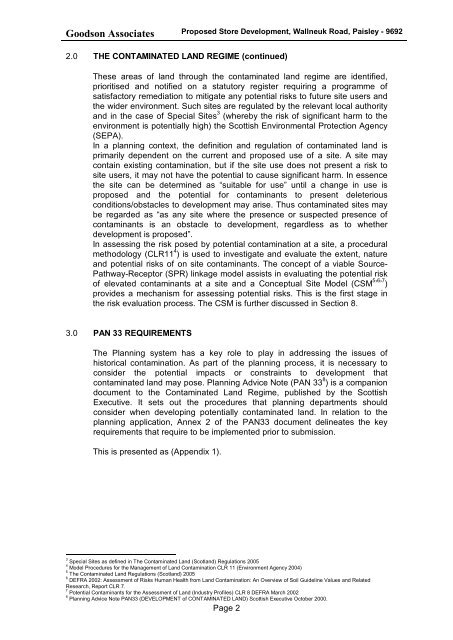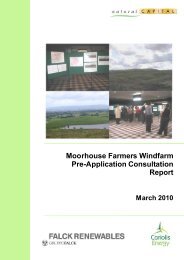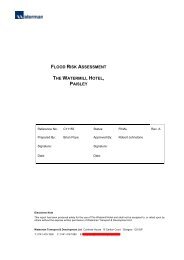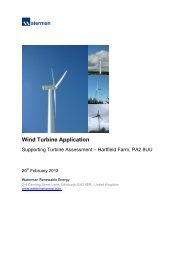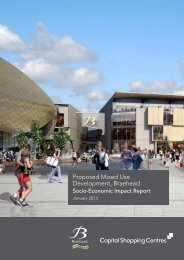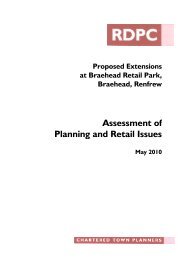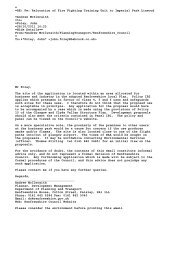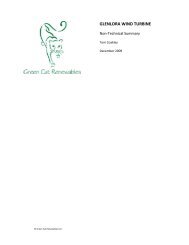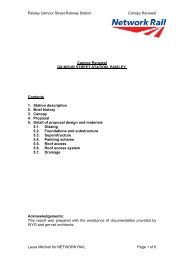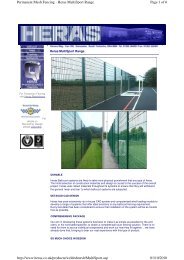Supporting documents - Renfrewshire Council
Supporting documents - Renfrewshire Council
Supporting documents - Renfrewshire Council
Create successful ePaper yourself
Turn your PDF publications into a flip-book with our unique Google optimized e-Paper software.
Goodson Associates<br />
2.0 THE CONTAMINATED LAND REGIME (continued)<br />
Proposed Store Development, Wallneuk Road, Paisley - 9692<br />
These areas of land through the contaminated land regime are identified,<br />
prioritised and notified on a statutory register requiring a programme of<br />
satisfactory remediation to mitigate any potential risks to future site users and<br />
the wider environment. Such sites are regulated by the relevant local authority<br />
and in the case of Special Sites 3 (whereby the risk of significant harm to the<br />
environment is potentially high) the Scottish Environmental Protection Agency<br />
(SEPA).<br />
In a planning context, the definition and regulation of contaminated land is<br />
primarily dependent on the current and proposed use of a site. A site may<br />
contain existing contamination, but if the site use does not present a risk to<br />
site users, it may not have the potential to cause significant harm. In essence<br />
the site can be determined as “suitable for use” until a change in use is<br />
proposed and the potential for contaminants to present deleterious<br />
conditions/obstacles to development may arise. Thus contaminated sites may<br />
be regarded as “as any site where the presence or suspected presence of<br />
contaminants is an obstacle to development, regardless as to whether<br />
development is proposed”.<br />
In assessing the risk posed by potential contamination at a site, a procedural<br />
methodology (CLR11 4 ) is used to investigate and evaluate the extent, nature<br />
and potential risks of on site contaminants. The concept of a viable Source-<br />
Pathway-Receptor (SPR) linkage model assists in evaluating the potential risk<br />
of elevated contaminants at a site and a Conceptual Site Model (CSM 5 ’ 6 ’ 7 )<br />
provides a mechanism for assessing potential risks. This is the first stage in<br />
the risk evaluation process. The CSM is further discussed in Section 8.<br />
3.0 PAN 33 REQUIREMENTS<br />
The Planning system has a key role to play in addressing the issues of<br />
historical contamination. As part of the planning process, it is necessary to<br />
consider the potential impacts or constraints to development that<br />
contaminated land may pose. Planning Advice Note (PAN 33 8 ) is a companion<br />
document to the Contaminated Land Regime, published by the Scottish<br />
Executive. It sets out the procedures that planning departments should<br />
consider when developing potentially contaminated land. In relation to the<br />
planning application, Annex 2 of the PAN33 document delineates the key<br />
requirements that require to be implemented prior to submission.<br />
This is presented as (Appendix 1).<br />
3<br />
Special Sites as defined in The Contaminated Land (Scotland) Regulations 2005<br />
4<br />
Model Procedures for the Management of Land Contamination CLR 11 (Environment Agency 2004)<br />
5<br />
The Contaminated Land Regulations (Scotland) 2005<br />
6<br />
DEFRA 2002: Assessment of Risks Human Health from Land Contamination: An Overview of Soil Guideline Values and Related<br />
Research, Report CLR 7.<br />
7<br />
Potential Contaminants for the Assessment of Land (Industry Profiles) CLR 8 DEFRA March 2002<br />
8<br />
Planning Advice Note PAN33 (DEVELOPMENT of CONTAMINATED LAND) Scottish Executive October 2000.<br />
Page 2


